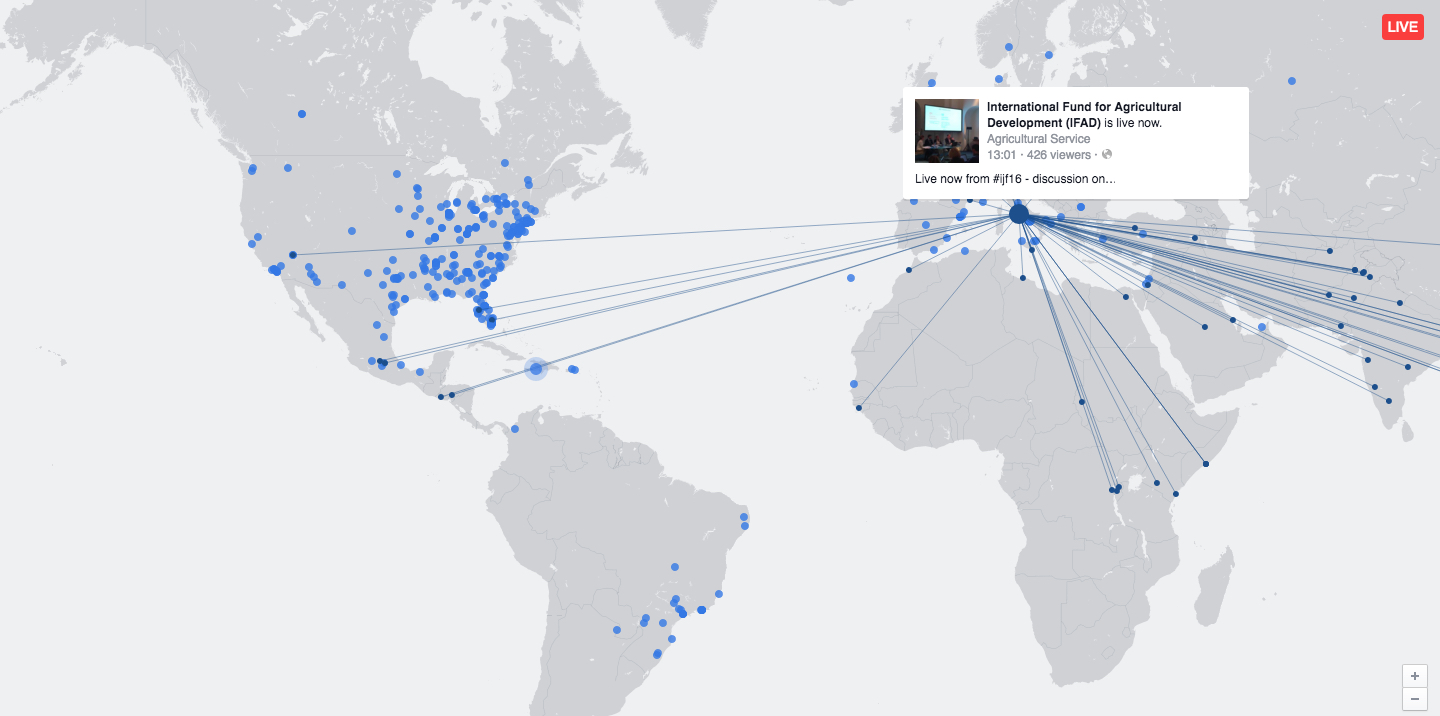
Around 5 p.m. on April 1, everyone in our little office crowded around my desk, watching a live video of baby goats roaming inside BuzzFeed Motion Pictures president Ze Frank’s office — a prank by staffers for his birthday. Would Frank be angry? Would the goats escape?? Would chaos ensue?! Five of us waited for the grand climax, baffled by our own interest, along with 81,000 other viewers.
One week later, BuzzFeed was at it again, lassoing the Friday afternoon bored-at-work Facebook crowd — including, the entirety of media Twitter — with a live video of two staffers putting rubber bands around a watermelon until the fruit exploded.
At peak, 807,000 were watching and waiting for the moment of explosion. (This is far from the first time an exploding watermelon has captivated the Internet.)This is the power of Facebook Live, the platform’s — and Zuckerberg’s — latest pet feature that allows users to pick up a smartphone and start broadcasting in real time to followers who happen to be scrolling down their Facebook feed at that moment, or who have subscribed to the broadcasts. Last week, ahead of its F8 developer conference (which starts Tuesday in San Francisco), Facebook introduced new features to help make Live a centerpiece of the platform.
(BuzzFeed disclosed that it’s one of several media partners Facebook is paying to use Live. Recode listed several others. I tried to ask some of the news organizations I spoke to for this story whether they were getting paid, but none were willing to fess up.)
Television comparisons were immediate. “The future of TV,” a CNBC headline declared. Wired made a list: “Seven TV shows with fewer viewers than BuzzFeed’s exploding watermelon video.” Poynter offered some perspective: “MSNBC’s average total dayside viewers in February: 526,000.” From Zuckerberg’s own Facebook page: “Live is like having a TV camera in your pocket. Anyone with a phone now has the power to broadcast to anyone in the world.”
For some news organizations, Facebook Live is a natural extension of broadcasting operations, with a built-in audience of Facebook users who have liked that page. BBC News, for instance, has more than 28 million followers there.
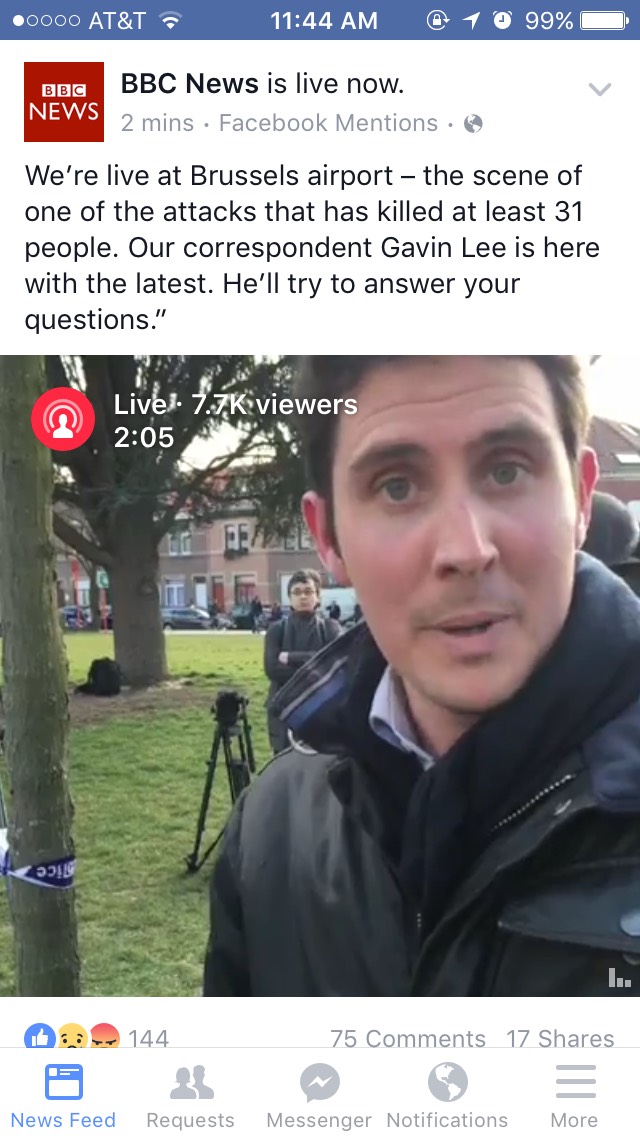 The BBC’s correspondents and reporters are “natural broadcasters,” Mark Frankel, social editor for BBC News, told me. “Every person I turn to and stick a camera in front of them, they feel very at home. The idea of going live through a smartphone is not an unnatural experience to them.”
The BBC’s correspondents and reporters are “natural broadcasters,” Mark Frankel, social editor for BBC News, told me. “Every person I turn to and stick a camera in front of them, they feel very at home. The idea of going live through a smartphone is not an unnatural experience to them.”
BBC News started experimenting with Facebook Live from within its newsroom, with news presenter Ros Atkins, who already hosts a “real-time news program” from London called Outside Source that covers social conversations around news stories of the day.
“He’s an absolutely brilliant broadcaster. We got him in the middle of our newsroom and every day we’d pick a subject,” Frankel said. “It could be the U.S. elections, a major developing story in a particular part of the world, an attack, a policy announcement. We got him paired up with another correspondent or expert from our news operations, and the two of them could spend an hour live on Facebook talking about that subject and answering questions. It evolved from being a fireside chat to being an incredibly engaging experience to a lot of our page subscribers.”
With its wealth of reporters worldwide, the BBC has been able to go Live from Brussels during and after the March 22 attacks, Live from Brazil with a clinic doctor answering questions about the Zika virus, Live from South Africa, Live from Texas, and so on (racking up thousands of comments on each Live video).This isn’t new territory. “Our correspondents have probably been using Periscope more than they’ve used Facebook Live, because they’re generally more active on Twitter,” Frankel said. Facebook has a slight advantage, he thinks, in that “the comments aren’t visible on the video directly, so you’re less interrupted by that communication process in real time.”
In (what else) a Live video interview, Chris Cox, Facebook’s chief product officer, said “we’re not thinking about it as a replacement [for traditional broadcast],” because the video quality and small screen size are still not comparable to TV, but “we’re going to wait and see.” (We won’t have to wait long. Tastemade, for instance, is producing 100 live daily shows each month for Facebook, “working closely with Facebook to optimize” its shows for the platform. Video-centric financial news company Cheddar launched on Live this week, looking a bit like someone recorded a TV screen with their phone.)
Fusion is another organization with television roots, and AMERICA host Jorge Ramos has been an aggressive advocate/poster boy for how Facebook would like journalists to embrace its Live feature.
 As I scrolled through videos from Fusion’s Facebook page, I stumbled across its Live show from Cuba. It included multiple correspondents in multiple locations, had noticeably higher sound and image quality than most videos, and was well-organized, with a real ending, not one of those ambiguous cutoffs typical of Facebook Lives.
As I scrolled through videos from Fusion’s Facebook page, I stumbled across its Live show from Cuba. It included multiple correspondents in multiple locations, had noticeably higher sound and image quality than most videos, and was well-organized, with a real ending, not one of those ambiguous cutoffs typical of Facebook Lives.
“Cuba was the first multi-camera Facebook Live for us. We’ve been collaborating with Facebook, and we were effectively able to produce a whole show and distribute it on Facebook,” said Dax Tejera, executive producer of AMERICA. “We originated the show from headquarters. I was in Cuba, and we had a reporter in Little Havana.” The team set the Live show during the lunch hour to catch people at their desks, scrolling through their Facebook feeds.
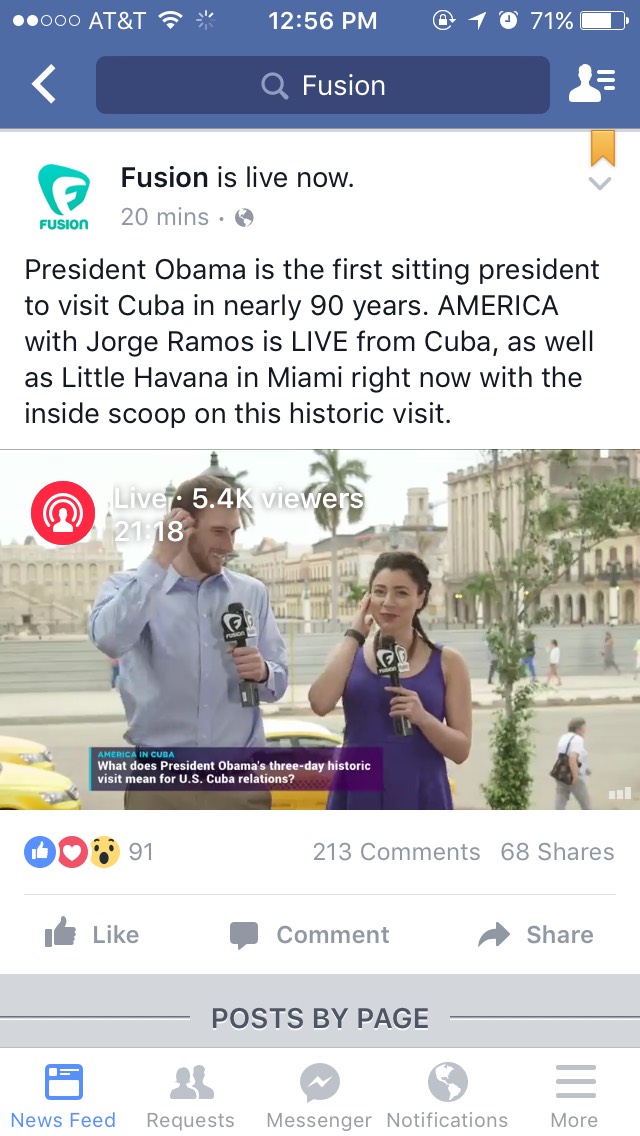 “The core things are the same as with any broadcast. Chief among them is engagement: looking at the comments as they come in live, reading them, acknowledging them, answering the questions,” Tejera said. “There’s something familiar here for people — some television shows do viewer mail, for example. But on Facebook, the live interaction and engagement with the audience in real time is extremely unique, and we love it. It informs what we’re doing from a production standpoint and helps us tell the story.”
“The core things are the same as with any broadcast. Chief among them is engagement: looking at the comments as they come in live, reading them, acknowledging them, answering the questions,” Tejera said. “There’s something familiar here for people — some television shows do viewer mail, for example. But on Facebook, the live interaction and engagement with the audience in real time is extremely unique, and we love it. It informs what we’re doing from a production standpoint and helps us tell the story.”
“It’s not TV. It’s a very different medium,” Jigar Mehta, Fusion’s VP of digital operations, emphasized. “User behavior is much more engaged in Facebook Live than it is in television, and the content that we create has to break out of the studio mentality.”
The Daily Beast is straddling that in-the-studio/in-the-field dynamic with two regularly scheduled shows. One is named after its Cheat Sheet daily digest and features editor-in-chief John Avlon sitting on a small set inside the newsroom discussing news of the day. The other, “Drink Cart,” features cocktails correspondent Noah Rothbaum making drinks and discussing culture on Friday afternoons. The shows perform respectably, capturing 20,000 to 30,000 views for around 20 minutes of in-depth chatter.
 “Facebook Live doesn’t work like TV,” Colin Jones, Daily Beast’s director of social, told me. “The scheduling doesn’t necessarily work, the audience doesn’t always want a recap like Cheat Sheet. They want us to go deep. Our news cycle, for instance, coincided with the attacks in Brussels, so we decided to go all in. We brought on senior editor Michael Weiss, and he was able to answer very focused questions from the audience about what’s next, what’s going to happen.”
“Facebook Live doesn’t work like TV,” Colin Jones, Daily Beast’s director of social, told me. “The scheduling doesn’t necessarily work, the audience doesn’t always want a recap like Cheat Sheet. They want us to go deep. Our news cycle, for instance, coincided with the attacks in Brussels, so we decided to go all in. We brought on senior editor Michael Weiss, and he was able to answer very focused questions from the audience about what’s next, what’s going to happen.”
“It’s one thing to have people on cable TV talking about what it all means, but it’s another to have experts engaging in real time as people ask very critical personal questions — about safety, travel bans, things like that — in a very simple, direct way,” Mike Dyer, Daily Beast president and publisher, said.
The Daily Beast is training individual writers and editors how to broadcast from their iPhones, so they can go live any time they’re out in the field. “This opens up all kind of new ways and products to tell a story that are not so much focused on production values,” Dyer said.
Everyone I spoke with was excited about the ease of going Live, and the quality and volume of comments beneath each video.
“It reminds me of working on the Internet in 1999, of doing something unfamiliar, throwing yourself into it suddenly, and not worrying too much if things don’t go right,” Katherine Bell, HBR.org editor, said. “Going Live was much more dynamic and exciting than we’d expected.”
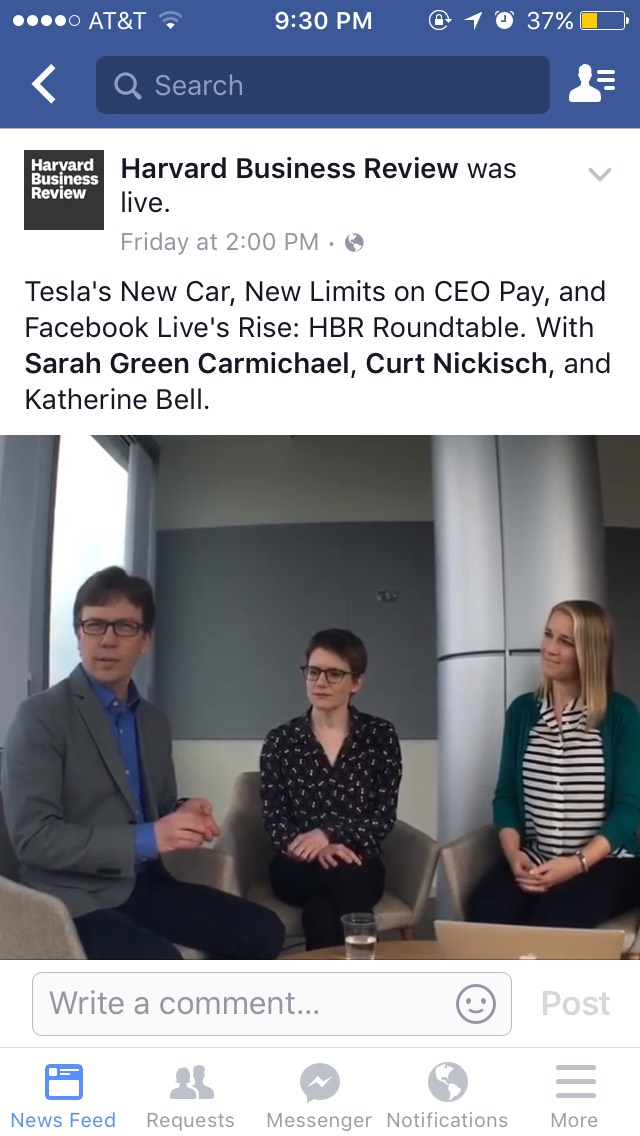 HBR’s live shows have centered around bringing in experts. In one, a Tuck School of Business professor gave a live lecture, whiteboard notes included. It got 73,000 views, 620 shares, and 328 comments.
HBR’s live shows have centered around bringing in experts. In one, a Tuck School of Business professor gave a live lecture, whiteboard notes included. It got 73,000 views, 620 shares, and 328 comments.
“The ability for the audience to ask questions is so integrated into the experience,” Bell said. Harvard Business Review caters to a very specific demographic, and its Facebook audience (a significant percentage from outside the U.S.) is already very active on the page. “Good questions kept coming in. we had to have two people on each broadcast, one keeping track of the comments and relaying them to the people on camera. Any time we mentioned a piece of HBR content or an idea on screen, we dropped the link into the comments.”
As simple as they are, these videos aren’t a matter of just picking up a phone.
“We’re putting more time into this than we ‘need’ to. We have to hit a certain standard, even in a new format that’s very casual and rough around the edges,” Bell said. “We still need to plan these out in advance, booking guests, making sure we have people lined up for the next few weeks, making sure we have backup plans. We also have to be flexible enough that we can drop everything if an author happens to be in the building or someone is at an event.”
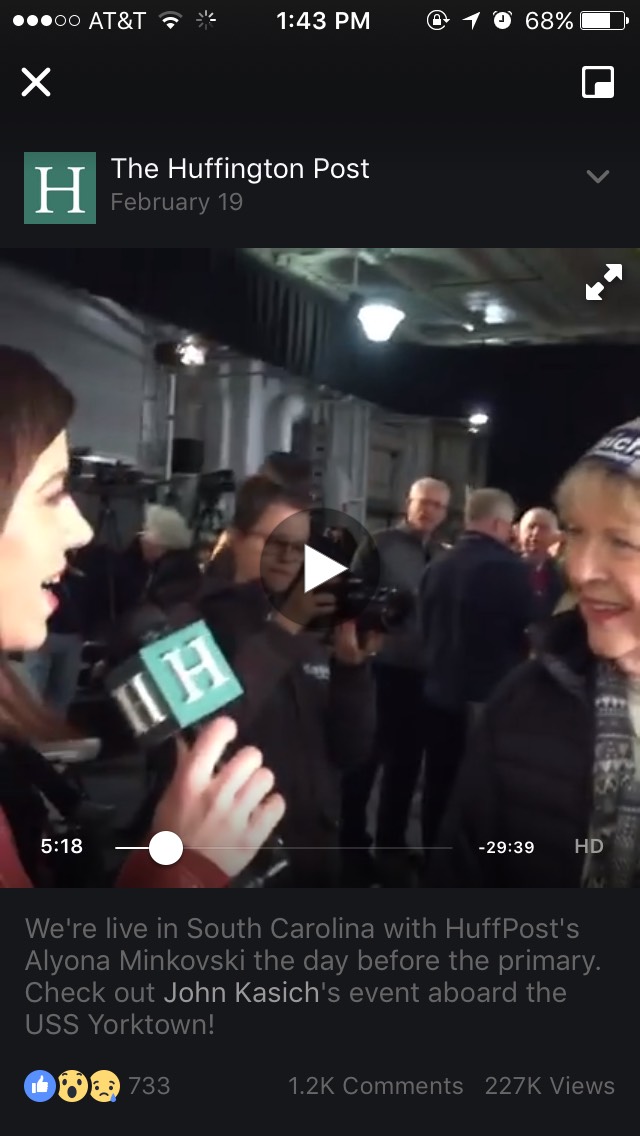 Challenges for outlets large and small include getting a consistent cellphone signal during Live broadcasts and somehow letting the flood of Facebook commenters know their questions were actually seen and not just thrown into the abyss. An otherwise fun behind-the-scenes with Meet the Press senior producer Shawna Thomas, for instance, was interrupted several times when Thomas lost signal in stairwells.
Challenges for outlets large and small include getting a consistent cellphone signal during Live broadcasts and somehow letting the flood of Facebook commenters know their questions were actually seen and not just thrown into the abyss. An otherwise fun behind-the-scenes with Meet the Press senior producer Shawna Thomas, for instance, was interrupted several times when Thomas lost signal in stairwells.
“Some places have Wi-Fi, but most of the time, it’s not as fast as the 4G LTE signals we can get,” Patrick McMenamin, Huffington Post Live supervising producer, said. “Our kits carry two iPhones and two MiFis with different service providers to increase our odds of finding a good signal if there’s trouble.” Signal issues have been the biggest problem in the Huffington Post’s unsuccessful streams: “We tried to go live from the Bernie Sanders watch party in New Hampshire shortly before he was expected to speak, but that’s exactly when everyone hopped on their phones, creating a bandwidth throttleneck. We couldn’t get a signal to stream until after the speech, as people were filing out.”
The Huffington Post considers comments a multi-person operation: It has three-person field teams for primary coverage, including a host, a producer, and a shooter to handle the iPhone and audio. A fourth team member in New York follows comments and chats the best ones to the host in the field.
“Trying to deal with the comments is like drinking water from a firehouse,” Tejera of Fusion said (the Live video of him reporting from Cuba also lost sound intermittently). “We’re hoping Facebook will eventually be able to help out with this.”
Frankel of BBC News described a few different methods his team has tried with correspondents out in the field to handle comments. In Brussels, “we had our correspondent out with a producer, the producer had the phone on a stick, and the reporter was walking and talking and looking at his own phone, where we were WhatsApping him with the best of the comments,” Frankel said. BBC News has also had a reporter hold a tablet with a Google Doc on it. A producer back at the base filtered the comments, picked out the best ones, and added them to the Google Doc, where the presenter could look down occasionally to pick some out.
“I think it’s really important to involve the comments. That’s the fundamental reason for doing it this way,” he said. “We’re not just trying to do broadcast TV on Facebook. We’re trying to reach and involve our audience on Facebook.”